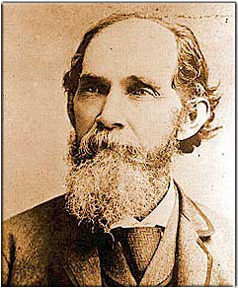George W. Baylor
1832 - 1916

George W. Baylor, Texas Ranger
George Wythe Baylor was born August 2, 1832 in Fort Gibson, Indian Territory. The family moved often during his early years. In 1836 they relocated to Natchez, Mississippi where his father died. Over the next several years the family moved to Fort Gibson to Pine Bluff, Arkansas, Little Rock, Arkansas, and finally back to Fort Gibson.
In 1845, Baylor moved to Texas to live with his brother John in Ross Prairie near La Grange. He went to Rutersville College and later, through the influence of his uncle R.E.B. Baylor, he attended Baylor University at Independence, Texas. He worked for a short time as a clerk with the Commissary Department of the U. S. Army at the Alamo in San Antonio.
Gold fever took him to California in 1854. 1856 finds Baylor in San Francisco and a member of the Vigilance Committee. According to family letters, George could not find steady employment or strike it rich in the gold fields. By late 1859 he was back in Texas and living with his brother in Weatherford.
Baylor joined the Confederate cause at the outbreak of the Civil War. Serving first with his brother's Arizona brigade, by late summer, he was aide-de-camp to Gen. Albert Sidney Johnston. Following the battle of Shiloh, Baylor returned to Texas and was elected colonel of the 2nd Cavalry Regiment of the Arizona Brigade. He also led a Cavalry regiment during the Red River campaign of 1864 and was commended for gallantry. Following the war, Baylor continued his restless lifestyle, never staying in one place for long.
In September of 1879, Baylor was commissioned a lieutenant in the Texas Rangers and ordered to take over the command of a detachment of Rangers in El Paso. Baylor was able, through his knowledge of Spanish and his friendships with many of the leading citizens of El Paso, to put to rest the lingering hatreds caused by the Salt Wars. He was soon involved in protecting the region from attacks from the Apaches. Baylor used local guides and worked closely with Mexican authorities on the south side of the Rio Grande. One of Baylor's greatest successes as a Ranger came in January 1881. For several weeks the U. S. Tenth Cavalry and the Rangers were kept busy in pursuit Victorio's band of Apaches.
In January 1881 a small band of Apaches attacked a stagecoach in Quitman Canyon. Following the cold trail, Baylor and his Rangers tracked the Apaches down the bank of the Rio Grande and into Mexico. Along the way they found items taken from the stage. The trail turned back into Texas, where they found a fresh camp site. Following the trail into the Eagle Mountains, the Rangers came across a camp that was only hours old. Baylor's men met up with a detachment of Rangers from Lt. Nevill's company at Eagle Springs. After more tracking, the Rangers finally came upon the Indian camp. A fight ensued on the morning of January 29.
The fight, though small, has come down through history as the last Indian battle in Texas. In 1882 Baylor was promoted to captain of Company A. In 1885 Baylor's Company A was disbanded due to budget cuts. After his Ranger service, Baylor was elected from El Paso to serve in the Texas State House of Representatives. He also served as clerk of the district and circuit courts for a number of years. He died on March 17, 1916 in San Antonio. He is buried in the Confederate Cemetery in San Antonio.
Suggestions for further reading:
- George W. Baylor, Into the far, wild country, El Paso: Texas Western Press, The University of Texas at El Paso, 1996
- Frederick Wilkins, The law comes to Texas, Austin: State House Press, 1999
- The New Handbook of Texas, Austin: The Texas State Historical Commission, 1996, Vol. 1
- Walter Prescott Webb, The Texas Rangers, Boston: Houghton Mifflin, 1935
- Darren L. Ivey, The Ranger Ideal Volume 2: Texas Rangers in the Hall of Fame, 1874 – 1930, Denton: UNT Press, 2018
- Texas, Texas State Archives, Austin, Texas
- Vertical Files, Texas Ranger Research Center, Texas Ranger Hall of Fame and Museum, Waco, Texas
